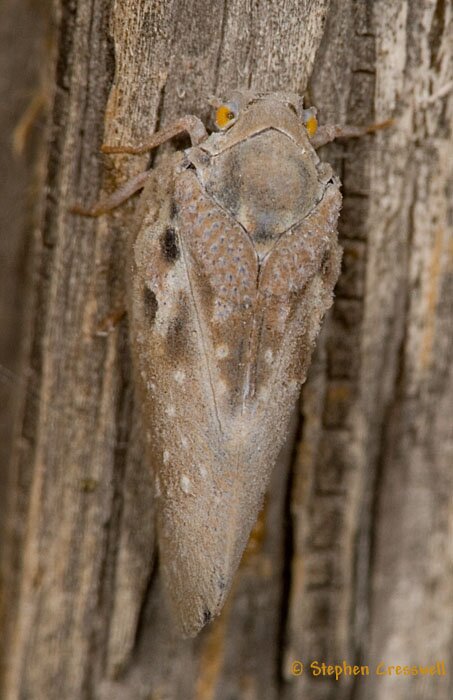Metcalfa pruinosa
Citrus Planthopper

Family: Flatidae
Subfamily: Flatinae
Length: 5.7-8.0 mm
Few insects have as catholic tastes as Metcalfa pruinosa when it comes to food plants. The common name refers to citrus, but in West Virginia this species is more likely to be found on Corn, Black Walnut, Basswood, Pawpaw, Sassafras, Gooseberry, Grape, and on various species of Oak, Elm, Maple, and Ash. Wilson (1980) listed some 40 food plants for this species.
Metcalfa pruinosa is covered with a waxy secretion that varies in thickness, so that the overall color of the insect ranges from whitish to gray to brown. This waxy pruinosity is undoubtedly what led Say to choose pruinosa as the specific epithet.
Typically there are a couple of dark spots near each wing base.

In the 1970s Metcalfa pruinosa was accidentally introduced into northern Italy, and became even more common there than in the United States. It has since spread to Spain, France, Switzerland, Slovenia, Croatia, the Czech Republic, Greece, and other countries.
In France and Italy, honeybees collect the honeydew of Metcalfa pruinosa and use it to make honey. The honey is marketed as "Metcalfa honey" (Wilson and Lucchi, 2007).
Metcalfa pruinosa overwinters in the egg stage, the eggs inserted into the bark of hardwoods including elms and black walnut. In a field study in southern Illinois, eggs hatched in late May and adults were present beginning in early July (Wilson, 1981).
Professor Wilson's drawings of the nymphs of Metcalfa pruinosa, all five instars, are elsewhere on this website.
Virant-doberlet and Žežlina (2006) studied the vibrational communication used in this species; their study was conducted in Slovenia. Males produce vibrational calls on a given plant, and if they receive no response from a female they typically fly or walk to another plant and try again. If a female is present on the plant, she may respond with a vibrational signal of her own, and the two may then exchange signals for some time before courtship and mating moves forward.


 Insects of West Virginia
Insects of West Virginia





